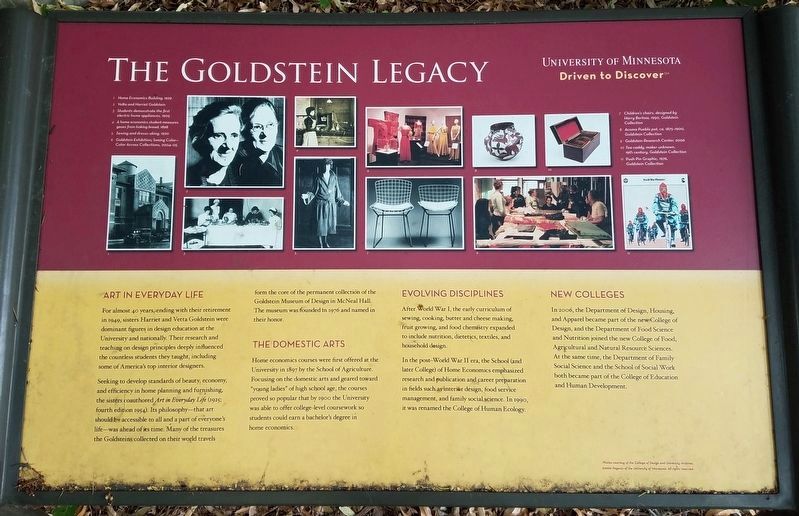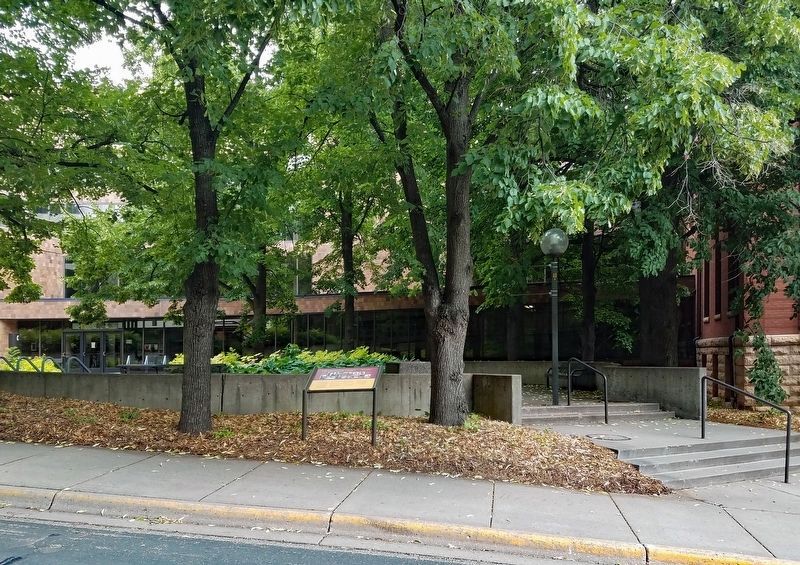Falcon Heights in Ramsey County, Minnesota — The American Midwest (Upper Plains)
The Goldstein Legacy
Art in Everyday Life
For almost 40 years, ending with their retirement in 1949, sisters Harriet and Vetta Goldstein were dominant figures in design education at the University and nationally. Their research and teaching on design principles deeply influenced the countless students they taught, including some of America's top interior designers.
Seeking to develop standards of beauty, economy, and efficiency in home planning and furnishing, the sisters coauthored Art in Everyday Life (1925; fourth edition 1954). Its philosophy—that art should be accessible to all and a part of everyone's life—was ahead of its time. Many of the treasures the Goldsteins collected on their world travels form the core of the permanent collection of the Goldstein Museum of Design in McNeal Hall. The museum was founded in 1976 and named in their honor.
The Domestic Arts
Home economics courses were first offered at the University in 1897 by the School of Agriculture. Focusing on the domestic arts and geared towards "young ladies" of high school age, the courses proved so popular that by 1900 the University was able to offer college-level coursework so students could earn a bachelor's degree in home economics.
Evolving Disciplines
After Wold War I, the early curriculum of sewing, cooking, butter and cheese making, fruit growing, and food chemistry expanded to include nutrition, dietetics, textiles, and household design.
In the post-World War II era, the School (and later College) of Home Economics emphasized research and publication and career preparation in fields such as interior design, food service management, and family social science. In 1990, it was renamed the College of Human Ecology.
New Colleges
In 2006, the Department of Design, Housing, and Apparel became part of the new College of Design, and the Department of Food Science and Nutrition joined the new College of Food, Agricultural and Natural Resource Sciences. At the same time, the Department of Family Social Science and the School of Social Work both became part of the College of Education and Human Development.
Captions:
1. Home Economics Building, 1929
2. Vetta and Harriet Goldstein
3. Students demonstrate the first electric home appliances, 1905
4. A home economics student measures gases from baking bread, 1898
5. Sewing and dressmaking, 1920
6. Goldstein Exhibition: Seeing Color—Color Across Collections, 2004-05
7. Children's chairs, designed by Harry Bertoia, 1950, Goldstein Collection
8. Acoma Pueblo pot, ca. 1875-1900, Goldstein Collection
9. Goldstein Research Center, 2006
10.
Tea caddy, maker unknown, 19th century, Goldstein Collection
11. Push Pin Graphic, 1976, Goldstein Collection
Erected 2009 by Regents of the University of Minnesota.
Topics. This historical marker is listed in these topic lists: Arts, Letters, Music • Education • Women. A significant historical year for this entry is 1897.
Location. 44° 59.101′ N, 93° 11.034′ W. Marker is in Falcon Heights, Minnesota, in Ramsey County. Marker is on Lower Buford Circle north of Buford Avenue, on the right when traveling north. The marker is on the Saint Paul Campus of the University of Minnesota, in front of the west entrance to McNeal Hall. Touch for map. Marker is at or near this postal address: 1985 Buford Avenue, Saint Paul MN 55108, United States of America. Touch for directions.
Other nearby markers. At least 8 other markers are within walking distance of this marker. Agricultural Excellence (about 600 feet away, measured in a direct line); The St. Paul Campus (about 600 feet away); Extending the U (about 600 feet away); Growing in Minnesota (approx. 0.2 miles away); Old Anatomy Building (approx. 0.2 miles away); Veterinary Medicine (approx. 0.2 miles away); World War I Memorial Grove (approx. ¼ mile away); A Century in the Sky (approx. 0.9 miles away). Touch for a list and map of all markers in Falcon Heights.
Credits. This page was last revised on November 21, 2021. It was originally submitted on November 21, 2021, by McGhiever of Minneapolis, Minnesota. This page has been viewed 156 times since then and 33 times this year. Photos: 1, 2. submitted on November 21, 2021, by McGhiever of Minneapolis, Minnesota. • J. Makali Bruton was the editor who published this page.

